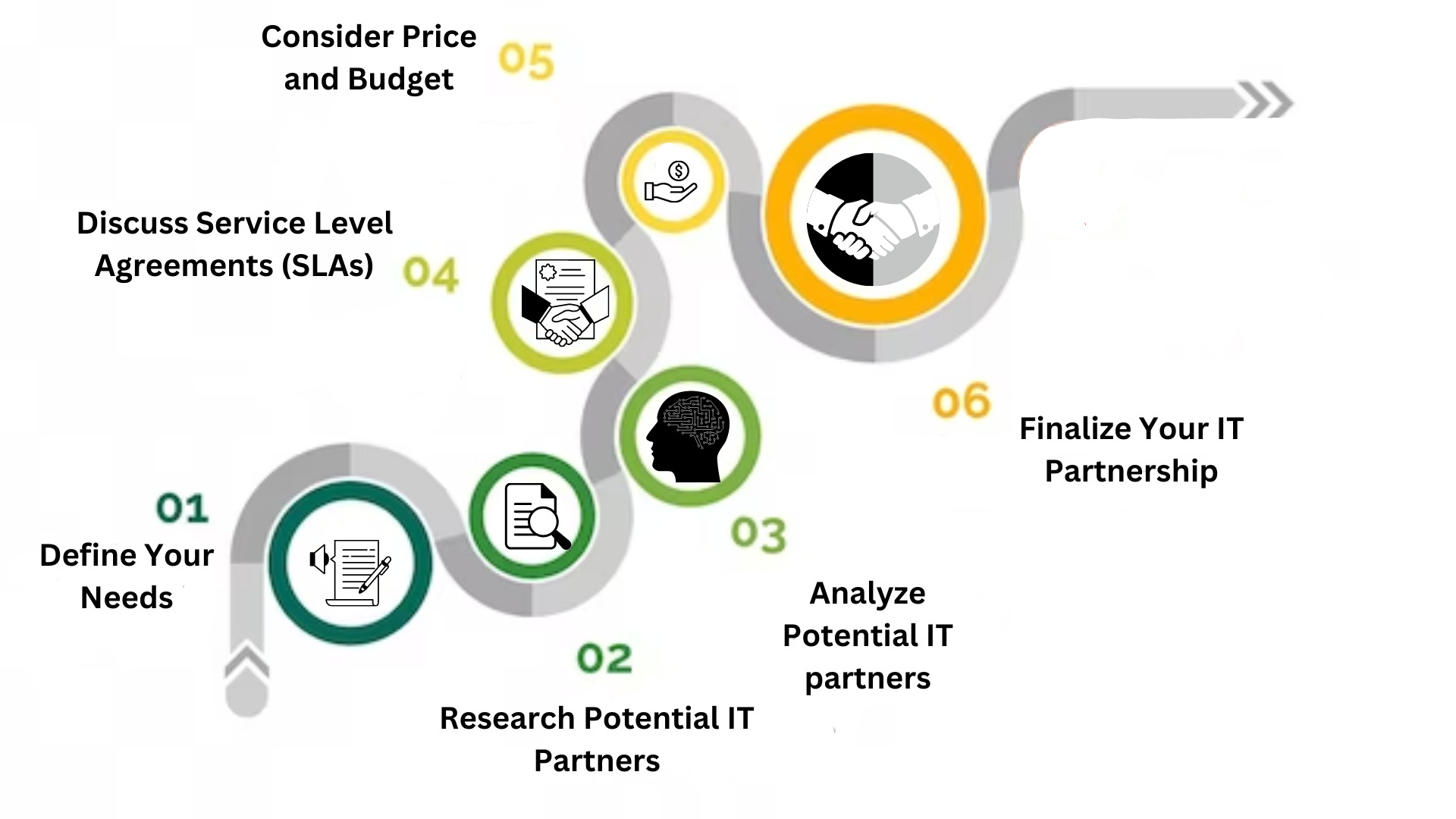No matter what domain or industry vertical your company operates in, it is important to have the right IT infrastructure in place. And it needs to be backed by proper IT support and IT consulting services too.
A good way to ensure that is to work with an IT service provider. And with the advent of the Internet, finding the right IT partner is possible online.
Partnering with the providers of the best IT services can provide numerous benefits. Like
- Increased productivity
- Improved security
- Reduced costs
- Access to their expertise, and
- Tried and tested methods of IT development and maintenance.
However, it can be a daunting task. Particularly for businesses that are not tech-savvy. Therefore, it is essential to take the time to evaluate potential IT partners thoroughly before making a decision.
This blog will walk you through the 6 key steps to finding the right IT partner online.

Step 1 – Define Your Needs
Before you set out to find the right IT partner online, you need to understand what is it that you are looking for in an IT partner. And the first step to knowing that is defining your business needs. It includes:
- Assessing your business requirements
- Identifying your technology gaps
- Outlining your IT partner expectations
If you are not sure about your needs, consider getting IT consulting services beforehand.
1.1. Assessing Your Business Requirements
This step involves understanding and highlighting your company’s tech priorities and what goals and objectives you need to achieve with an IT partner.
Try answering the following questions:
- What business processes do you want to improve?
- Which business areas need the most focus?
Answers to these questions will help you understand what the key capabilities of an IT partner who can offer you the best IT Services
1.2. Identifying Your Technology Gaps
Next, identify the technology gaps in your organization. If you have availed of IT consulting services, you would have a list of the gaps. If not, you can self-assess your business functions to find gap areas. It basically involves identifying areas where your business processes can be improved through technology.
Understand if any tasks can potentially be automated. Or if you require an entirely new software application. Finding an ideal partner becomes simpler when you know exactly what kind of technology service you require.
1.3. Outlining Your IT Partner Expectations
Finally, outline your expectations for your IT partner.
Try to articulate your thoughts around what is the response time that you are expecting, and what support capabilities you expect them to have, and how available you want them to be for you.
Step 2 – Research Potential IT Partners
After you have identified all your business needs, the next step is to look for potential IT partners. This involves identifying possible types of IT partnerships and finding potential IT partners.
2.1. Exploring the Different Types of IT Partnerships
Depending on your needs, you can choose to partner with IT companies in different ways. Some options include partnerships for:
- IT services
- Cloud services
- Cybersecurity services
- Application management services
- Software development services
Identify which of these partnership types is the most suitable for you.
2.2. Finding Potential IT Partners
Based on the kind of IT partnerships you are looking for, you can use B2B directories like TopDevelopers.co to identify potential IT partners.
Such platforms give you a quick, clear, and accurate idea about the top IT companies, their overview, pricing range, and their customer reviews.
You can select 3 to 5 potential partners at this stage.
Step 3 – Analyze Potential IT partners
Once you have identified 3 to 5 potential IT partners, you need to start assessing their capabilities.
The key factors based on which you should analyze potential IT partners are discussed below.
3.1. Online Reviews and Testimonials
Start by investigating online reviews and testimonials. Check review sites such as Google My Business for feedback from past customers.
3.2. Website Quality And Social Media Presence
Next, assess the IT partner’s website quality. A well-designed website that is easy to navigate, provides detailed information about services and showcases case studies can indicate a professional and reliable IT partner.
And if a company that is active on social media can provide valuable insights into its culture, values, and expertise. Check if they share relevant and informative content, engage with their followers, and respond to inquiries and comments promptly.
3.3. Communication And Collaboration Capabilities
Effective communication is essential for a successful IT partnership. Analyze the IT partner’s communication channels and response time.
Do they respond promptly to inquiries?
Do they provide regular updates on project progress?
What collaboration and communication tools do they use?
How fast or proactive an IT partner is in communication speaks volumes about their dedication to customer service.
3.4. Flexibility
Consider if your selected IT partner can adapt to changes in business needs, accommodate urgent requests, and offer customized solutions.
3.5. Security Capabilities
Security is a critical aspect of any IT partnership. So it is important to review their security measures. This involves investigating their security policies, assessing data privacy measures, and evaluating their disaster recovery capabilities.
Consider if they comply with industry regulations such as GDPR and CCPA and if they have measures in place to protect sensitive data. Select an IT partner that prioritizes data privacy and security.
3.6. Disaster Recovery Capabilities
Consider if your preferred IT partner has proper backup and recovery systems in place and if they conduct regular disaster recovery testing. An IT partner with robust disaster recovery capabilities can minimize downtime and ensure business continuity.
3.7. Support and Maintenance Capabilities
Support and maintenance capabilities are crucial for ensuring the smooth operation of your IT infrastructure. So it is important to evaluate their support and maintenance capabilities. This involves analyzing the IT partner’s support capabilities, investigating their maintenance capabilities, and checking their availability and responsiveness.
Based on the above factors, you’d be able to identify the top 2-3 potential IT partners. Now it is time to take things ahead.
Step 4 – Discuss Service Level Agreements (SLAs)
Service level agreements (SLAs) provide a framework for measuring the IT partner’s performance and ensuring accountability. The next step to finding the right IT partner online is to discuss SLAs. This involves understanding SLAs, identifying key performance indicators (KPIs), and negotiating custom SLAs.
4.1. Understanding SLAs
An SLA outlines the services to be provided, the performance metrics to be measured, and the consequences of not meeting the agreed-upon metrics. Understanding SLAs can help you set realistic expectations for the IT partnership.
4.2. Identifying Key Performance Indicators (KPIs)
Next, identify the KPIs that are relevant to your business needs. Consider factors such as uptime, response time, and ticket resolution time. Identifying KPIs can help you evaluate the IT partner’s performance and ensure that they meet your business requirements.
4.3. Negotiating Custom SLAs
Finally, negotiate custom SLAs that align with your business requirements. Consider factors such as the severity of issues, the level of support required, and the consequences of not meeting SLA metrics.
Step 5 – Consider Price and Budget
Price and budget are essential factors to consider when selecting an IT partner. The next step to finding the right IT partner online is to consider price and budget. This involves understanding IT service pricing models, reviewing IT service costs, and comparing IT services.
5.1. Understanding IT Service Pricing
IT services may be priced using a variety of models such as fixed pricing, hourly rates, and project-based pricing. Understanding pricing models can help you choose the one that best aligns with your business needs.
A good IT partner will give you the flexibility to choose a pricing model that suits your budgetary requirements, while still ensuring that you get the services you require.
5.2. Reviewing IT Service Costs
Next, review the IT service costs. Consider if they fit within your budget and if they provide value for money. While cost is an essential factor, it should not be the only factor considered when selecting an IT partner.
5.3. Comparing IT Services
Once you have received quotes from multiple IT partners, consider factors such as the level of support provided, the experience and expertise of the IT partner, and the quality of services offered. Comparing IT services can help you choose an IT partner that provides the level of support your business requires at a reasonable cost.
Step 6 – Finalize Your IT Partnership
Once you have completed the above steps, you can finalize your IT partnership. This involves preparing for onboarding, which includes creating an onboarding plan, setting up communication channels, and defining the roles and responsibilities of both parties.
You should define the scope of the project, set project timelines, and establish communication protocols.
Setting clear expectations during the onboarding phase can ensure a smooth transition to the IT partnership.
Getting Started With The Right IT Partner
Finding the right IT partner online can be a challenging task. But by following the above steps, you can select an IT partner that provides the level of support your business requires.
Want to quickly connect with an ideal IT partner? Schedule a consultation with experts at SynergyTop.
Why Choose SynergyTop As Your IT Partner?
- 5-star ratings on Clutch and GoodFirms
- 9+ years of experience in the IT industry
- Strong digital presence showcasing our stability and reliability
- Proactive communication
- Use of industry-leading collaboration tools like Jira, Trello, Asana, etc.
- Use of Agile methodology under the guidance of certified SCRUM masters
- Security best practices are followed at every step, with proper documentation
- Robust disaster recovery capabilities with a proactive team that’s available around the clock.
- Flexible packages and pricing to meet your budgetary needs.
- Expertise in a broad spectrum of IT services including web, mobile, eCommerce, and software development, product engineering, legacy application modernization and application management services, ERP implementation, and 360-degree digital marketing.
- Hands-on experience working with cutting-edge technologies including AI/ML, blockchain, IoT, and more for complete digital transformation.
So don’t wait, schedule a no-obligation initial consultation with the IT experts at SynergyTop today.
















